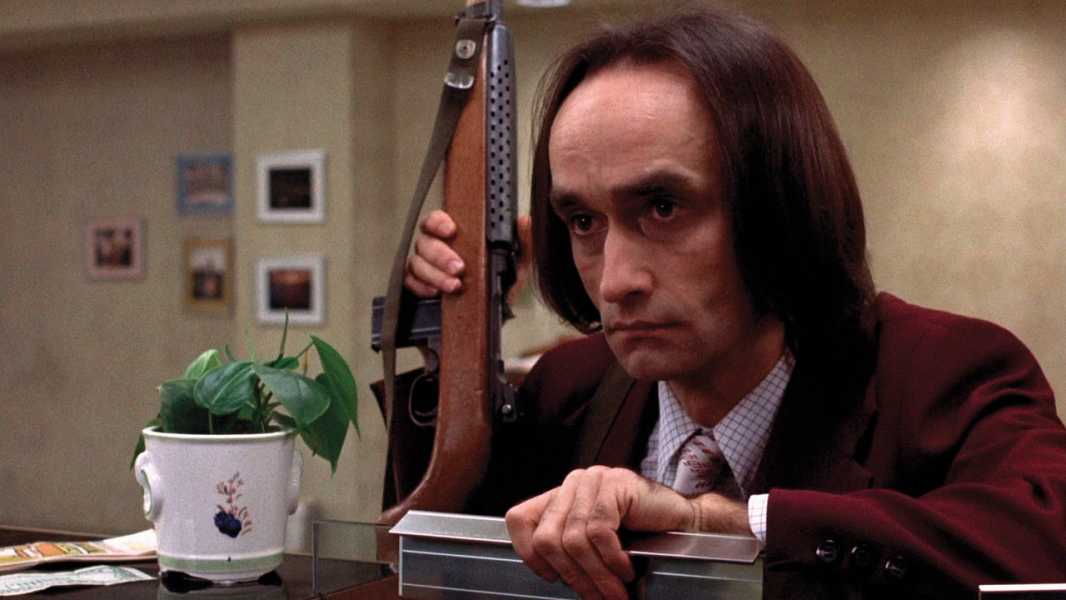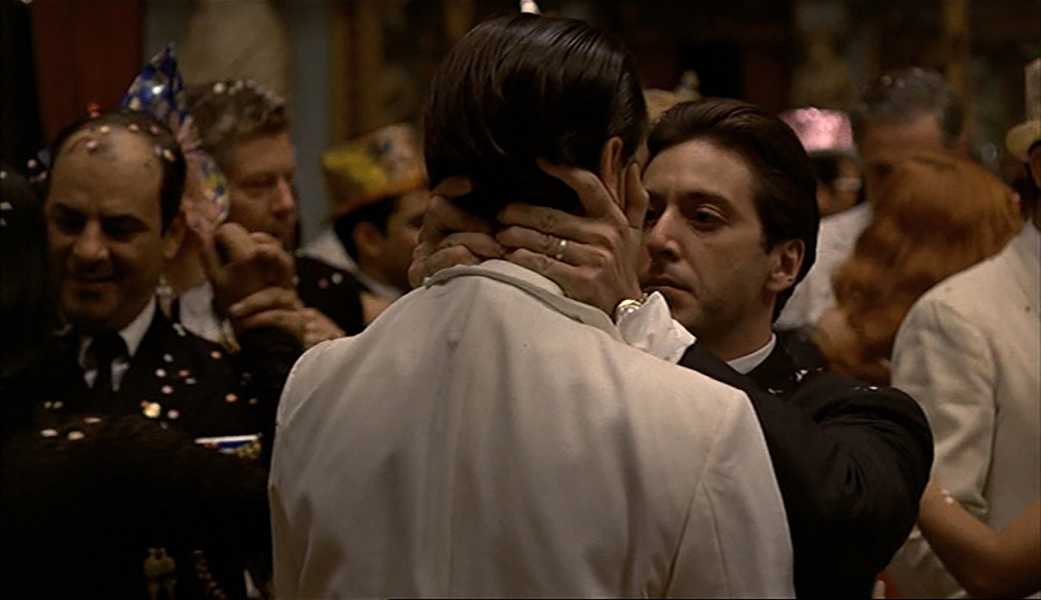
Save this storySave this storySave this storySave this story
The list of offenses is long, but let’s start with his jacket. It is a rich shade of burgundy, the color of a bruise, and not remotely flattering to the pale body it covers. Throughout the pitiful non-heist in “Dog Day Afternoon” (1975), while everyone else in the un-air-conditioned bank sheds layers or unbuttons blouses, the jacket stays put, getting soggier and dirtier. The robber is still wearing it when he scolds a hostage for smoking. “If I die of cancer, it’ll be half your fault,” she teases. “No,” he mutters, echoing what some teacher or parent must have told him long ago, “it’s because you’re weak.” Everything about this character, who goes by Sal, is pathetic, unless it’s repugnant. There is no reason for us to sympathize with him, and therefore we do. The hostages do, too: just before he gets shot in the head, one of them gives him a rosary and tells him not to be scared. We don’t need to be told that Sal has been scared his entire life.
Three years after the film’s release, the actor John Cazale died of cancer at the age of forty-two—much too young, but old enough to have played Sal and done impeccable supporting work in “The Conversation,” “The Deer Hunter,” and the first two “Godfather” films. In his five cinematic roles, he endangers countless lives, waves a gun in a friend’s face for no reason, steps on a bride’s wedding dress for no reason, leers and whines and bullies and snivels and beds cocktail waitresses two at a time. But there is something almost adorable, even saintly, about the way he sins. If I worked in a bank, I know who I would want to rob me.
“From the moment you see him onscreen . . . he’s so strange-looking.” The speaker is Steve Buscemi, one of the principal talking heads of “I Knew It Was You: Rediscovering John Cazale,” a 2009 documentary that helped inspire a fresh flurry of interest in the actor’s short career. Buscemi is not wrong. Cazale’s forehead was a vast wilderness. His hair was a haunted wood. His eyes were black holes from which no light ever returned. Let’s be clear, though: strange compared with who? If you noticed someone like Cazale on the subway, you wouldn’t blink. In the room I’m sitting in as I write this, there are at least two people who could easily be related to him. He was an everyday-looking person in a profession where beauty is the default and everyday means bizarre. Hair-splitting? Possibly, but we’re also getting to the gist of what made him so good.

John Cazale and the actor Al Pacino in “The Godfather: Part II.”Photograph courtesy Paramount
Revisiting Cazale’s films, the subject of a new series at Metrograph, convinced me that he was and still is Hollywood’s undisputed master of the everyday. I don’t mean everyman acting à la Jimmy Stewart or Tom Hanks, where the main qualifications are being handsome and preternaturally charismatic. Cazale excelled, instead, at playing people who are weak, weird, unprincipled, and visibly uncomfortable in their own skins. Like I said, everyday.
The late sixties and early seventies were a good time for actors who looked nothing like Hollywood but went there anyway. (This was the era when Dustin Hoffman beat out Robert Redford for the lead in “The Graduate.”) For most of the sixties, Cazale acted Off Broadway and made extra money as a cabdriver or as a messenger for Standard Oil, where one of his co-workers happened to be Al Pacino. Frazzled, big-city abjection was an early specialty—in Israel Horovitz’s “The Indian Wants the Bronx,” he gets roughed up (by Pacino, no less) while waiting for a bus. By 1971, the year the casting director Fred Roos told Francis Ford Coppola that Cazale would make a good Fredo Corleone, the actor had two Obie Awards. A few seasons too soon or too late and he may not have transitioned to film so gracefully.
Cazale’s timing was excellent. His self-awareness was better. From the jump, he knew what he was good at: being odd but never in a grand way, the wonky yardstick by which the other characters’ tortured depths are measured. When we meet Cazale in “The Conversation,” we’ve already been introduced to Gene Hackman, the lead. But Cazale is the one who shows us what kind of movie this will be. “You goin’ to the convention tomorrow?” he asks as he crouches in his truck, tapping at surveillance equipment, and immediately we understand that we’re watching espionage without a drop of James Bond, espionage as a nine-to-five with small talk and coffee breaks. Cazale’s character is a creep, of course, but a creep you could get a beer with. As if to underscore the point, he later invites Hackman, who plays his devoutly religious boss, out for a drink. Hackman turns him down and scolds him for taking the name of the Lord in vain. In the Vietnam War epic “The Deer Hunter,” Cazale’s dynamic with Robert De Niro isn’t so different; his purpose is to act life-size so that De Niro can be colossally tragic. When the two steelworkers go hunting in the mountains, the sound of De Niro’s shout fills the emptiness like a thunderstorm. Cazale’s squawk couldn’t fill a paper bag.
There is nothing in movies like that squawk. It cracks and shakes, as though with the memory of some gruesome injury. In Cazale’s most famous scene from “The Godfather: Part II,” Michael Corleone (Pacino) stands and barely opens his mouth. Fredo slouches in his chair, as though on a psychiatrist’s couch, and vomits up what he’s been mumbling under his breath for years:
You’re my kid brother, and you take care of me? Did you ever think about that, huh? Did you ever once think about that? Send Fredo off to do this, send Fredo off to do that. Let Fredo take care of some Mickey Mouse night club somewhere. Send Fredo to pick somebody up at the airport. I’m your older brother, Mike, and I was stepped over!
It is hard to know how much to say about a speech that has been analyzed for the last half century, so I’ll limit myself to two points. The first is the way that Cazale’s right arm flops around like a fish in a boat—he can’t control his own body, let alone the Corleone empire. The second point is so obvious that only a brilliant actor could make us forget it: at this stage in the movie, we should root for Michael and hate Fredo. Michael is the dutiful son who works day and night to provide for his family. Fredo has never worked for anything. His stupidity almost got two of his family members killed. The only thing he has going for him is the one that matters most: Michael is a machine, and Fredo is one of us. Side against him at your own peril.
The war between “us” (despicable but still human) and the machine people (in the right but sociopathic) is more or less the point of “Dog Day Afternoon,” Cazale’s third film with Pacino and the one where he pushed past ordinary humdrum brilliance and made it all the way to perfection. As Sonny, the lead bank robber, Pacino gets most of the juicy scenes and theme-baring lines: “Y’know, the guy who kills me, I hope he does it ’cause he hates my guts, not ’cause it’s his job,” he tells a cyborgian F.B.I. agent who is clearly this film’s true villain. Nevertheless, as Sal, Cazale has the tougher part, working in nanoseconds and millimetres and making them all count. He waves his gun and squawks at the bank’s secretaries; they scream, of course, and his eyes widen almost subliminally. When Sonny asks Sal if there is anybody he wants to call on the phone before they flee the country, Cazale refuses to milk the moment for pathos. After thinking for a few beats, no longer or harder than you’d think about what you had for breakfast today, he shakes his head. He can’t begin to understand what’s wrong with himself. But if you don’t look at this man and see parts of yourself, the ones you can barely stand to think about, I humbly suggest that you are not really trying. On behalf of anyone who has ever been brushed off or stepped over, all the damaged kids limping through adulthood, all the poor souls who still haven’t figured out what to do with their arms when they’re having a conversation: te salut, Don Cazale. Everyday doesn’t come to Hollywood every day. ♦
Sourse: newyorker.com